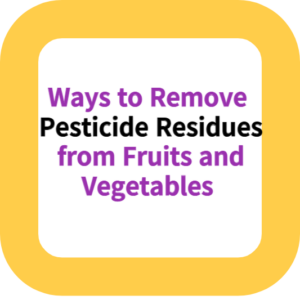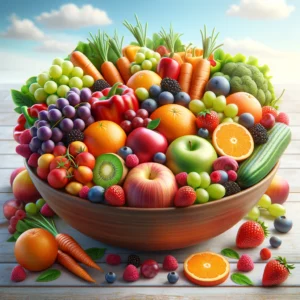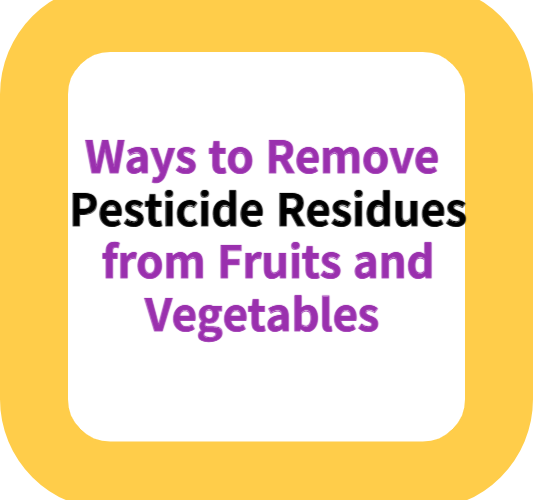Ways to Remove Pesticide Residues from Fruits and Vegetables
In today’s health-conscious world, understanding how to effectively reduce pesticide residues on fruits and vegetables is more crucial than ever. Our newest post delves deep into the intricacies of pesticide types – from contact to systemic – and their impacts on our food.
Our guide offers practical tips and insights for health-minded individuals looking to balance their concerns about pesticides with the benefits of a nutritious, fruit and vegetable-rich diet. Join us as we unravel the complexities of keeping your produce clean and safe, ensuring a healthier lifestyle for you and your family.
Ways to Remove Pesticide Residues from Fruits and Vegetables

Introduction: The Complexity of Pesticide Removal from Produce
In today’s agriculture-heavy world, understanding the complexities of pesticide use and removal from fruits and vegetables is increasingly important. Pesticides, both contact and systemic, are extensively used to protect crops but pose a challenge when it comes to ensuring the safety of our food.
This expanded guide dives deeper into the types of pesticides, their impacts, and the most effective methods for reducing pesticide residues on produce.
1. Understanding Pesticide Types: Contact and Systemic
Contact Pesticides: These are applied to the surface of plants, functioning similarly to a skin ointment, targeting external pests and fungal infections.
Systemic Pesticides: These are absorbed and circulated within the plant, targeting internal pests and microbes. They are akin to antibiotics in their mode of action, and their systemic nature makes them particularly challenging to remove.

2. The Ineffectiveness of Simple Washing
Contrary to common belief, mere washing of fruits and vegetables often fails to remove significant amounts of pesticides. While it can remove some surface contaminants, systemic pesticides absorbed into the plant tissues remain largely unaffected.
3. Recommended Methods for Reducing Pesticide Residue
Plain Water Rinse: Basic but partially effective, especially for reducing bacterial contamination.
Vinegar Solution: Proven to be significantly effective in reducing residues on certain produce like tomatoes.
Baking Soda Solution: Demonstrated in studies to effectively remove surface pesticides from apples and potentially other produce with similar skin characteristics.
4. Preparing Produce: Peeling, Cooking, and Canning
Beyond washing, peeling can remove the outer layer where pesticides accumulate. Cooking and canning may further reduce pesticide levels, as many degrade with heat. These methods can be more effective than washing alone but may also remove some of the nutritional value.
5. The Limitations of Washing and Preparations
It’s important to recognize that no washing or preparation method can completely eliminate all pesticides, particularly those that have penetrated beyond the surface of the produce.
6. The Role of Organic Produce in Reducing Pesticide Exposure
Organic farming uses non-synthetic pesticides, but this doesn’t guarantee complete safety. Organic produce may still contain pesticide residues, though typically in lower and less harmful amounts compared to conventional farming.
7. Practical Tips for Reducing Pesticide Consumption
Regularly incorporating diluted vinegar sprays and baking soda soaks can be effective. Peeling and cooking certain fruits and vegetables can also help.
However, the nutritional benefits of consuming a variety of produce should not be overlooked in the quest to reduce pesticide exposure.
8. Navigating the Challenges of Fresh Pesticides and Water-Insoluble Formulations
Freshly applied pesticides and water-insoluble formulations pose a greater challenge. These types of pesticides are designed to adhere more strongly to plants, making them resistant to simple water washes.
9. Leveraging Local and Organic Sources
Engaging with local farmers to understand their pesticide usage and opting for organic produce when possible can be beneficial strategies. While organic produce may not be completely free of pesticides, it generally involves the use of less harmful substances.
Conclusion: Balancing Pesticide Concerns with Healthy Eating Habits
While completely removing all pesticides from fruits and vegetables is a challenging task, being informed about and utilizing various cleaning and preparation methods can significantly mitigate exposure.
Opting for organic produce and understanding the farming practices of your local producers can also contribute to reducing pesticide intake. However, it’s crucial to maintain a balanced perspective, recognizing the importance of fruits and vegetables in a healthy diet and not letting concerns over pesticides deter from their consumption.
